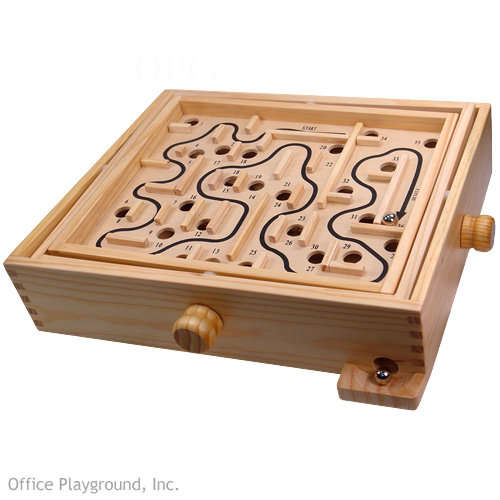Summary of Servo Controlled Labyrinth using Microcontroller ATmega32
This project modifies a classic wooden labyrinth game by replacing its two manual knobs with standard servos controlled by an ATmega32 microcontroller, allowing automated play. The build uses readily available wooden parts and materials combined with electronic components like servos and microcontroller programming. Key modifications include adapting servo horns to fit knobs, upgrading strings to strong silk for better friction, and reinforcing the labyrinth board with insulating tape and paper to keep the ball in play. The design encourages creativity, offering scope for further improvements and customization.
Parts used in the Servo Controlled Labyrinth Project:
- Wooden Labyrinth (280/230/60 mm)
- Wooden board (400/350/20 mm)
- 4 pieces of wood (30/30/10 mm)
- 2 pieces of wood (150/155/10 mm each)
- 2 L-shaped wood pieces (120/27/4 mm each side)
- 4 L-shaped wood pieces (34/32/8 mm & 18/32/8 mm)
- 600 mm strong silk string
- 8 rubber pieces (30/30/1 mm each)
- 4 stainless steel L brackets (32/32/1.5 mm)
- 8 bolts (40/5 mm) with nuts and washers
- Small wood screws and nails
- A piece of paper (A4 size)
- Hot glue
- Contact adhesive
- Insulating tape
- 2 Hitec HS-311 Standard servos
- AVR ATmega32 microcontroller and programmer (AVR-LIP by DeccanRobots)
- 2 straight switch knobs
- Breadboard
- Wires and pins
- Various hand tools (saw, screwdriver, hammer, sharp knife, scissors, clamp)
Do you know this classic wooden labyrinth game with two knobs for X and Y rotation?
So, I’ve decided to modify one by connecting two standard servos to the knobs and let a microcontroller (ATmega32) play the game.
Credits:
– To CarlS www.instructables.com/id/Servo-Controlled-Marble-Maze/ for inspiration.
– To the AVR freaks www.avrfreaks.net especially Dean (aka abcminiuser) for his excellent tutorials.
Please, feel free to write ideas for improvements and modifications.
Materials, Parts and Tools
I found all the materials for this project laying around at home and there were no plans nor designing. I just took the materials and thought how I can assemble them altogether.
You can use other materials and basically it’s a good practice to design and make plans beforehand.
Materials:
1 wooden Labyrinth – 280/230/60 mm
1 wooden board – 400/350/20 mm
4 pieces of wood – 30/30/10 mm
2 pieces of wood – 150/155/10 mm each
2 pieces of wood, L shaped – 120/27/4 mm each side
4 pieces of wood, L shaped – 34/32/8 mm & 18/32/8 mm each
600 mm long strong silk string
8 pieces of rubber – 30/30/1 mm each
4 L brackets, stainless steel – 32/32/1.5 mm each
8 bolts (40/5 mm) with nuts and washers
A bunch of small wood screws and nails
a piece of paper, A4 for example
hot-glue
contact adhesive
insulating tape
Parts:
2 Hitec HS-311 Standard servos
AVR ATmega32 and a programmer – I use the AVR-LIP (EC-AVR) by DeccanRobots
2 straight switch knobs
1 breadboard
Some wires and pins
Tools:
saw, screw-driver, hammer, sharp knife, scissors, clamp etc.
Labyrinth Modifications
Cut the servo horns (#13 R-D) just to make it symmetrical and use a hot glue to connect it to the switch knobs (90 deg. to the knob’s pointer).
Replace the two wooden side knobs with these switch knobs in order to calibrate the labyrinth easily.
To improve the strings/bars friction, replace the two nylon strings with a strong silk string and put some contact adhesive around the steel bars.
Put insulating tape on the inner side of each labyrinth’s hole and round pieces of paper on the outer side so the ball will stay on the board as long as you test the game.
For more Detail: Servo Controlled Labyrinth using Microcontroller ATmega32

